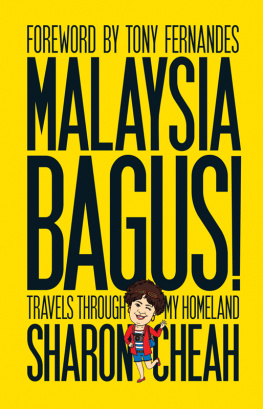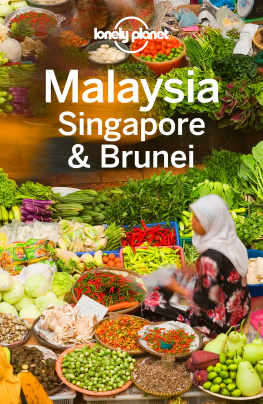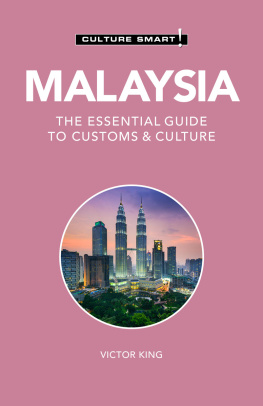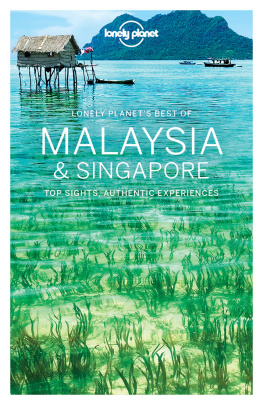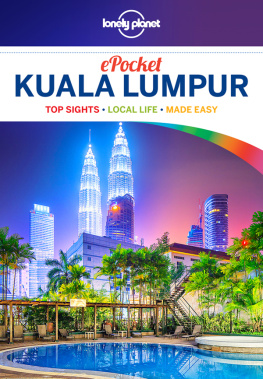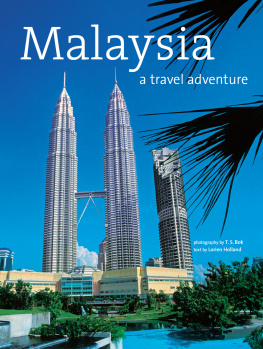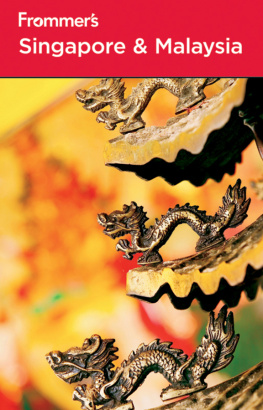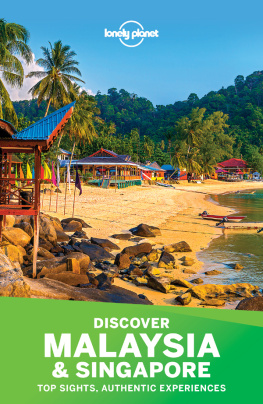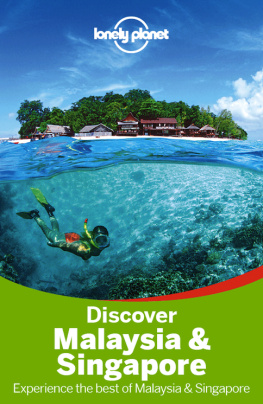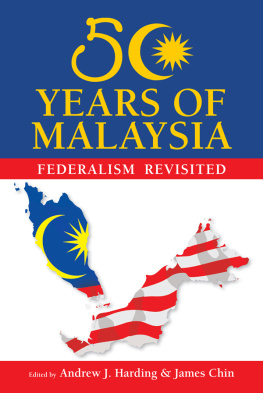A truly engaging read, bursting with insight and local flavour! With a reporters instinct and a delightful eye for detail, Sharon shows us exactly why Malaysia Bagus!
GEOFFREY EU, travel writer and former Editor of Insight Guides
Why are there so many Malaysians abroad? That may be the subject for another book. In this one, Sharon gives the millions who make up the Malaysian diaspora a vicarious means of going home, and its a great book for non-Malaysians too.
CLARISSA TAN, journalist at The Spectator (UK) and winner of the Shiva Naipaul Prize for travel writing
An eye-opener for those of us whose understanding of Malaysia is limited to news headlines and the occasional sojourn to a JB seafood stall. Theres nothing like exploring a country with a knowledgeable friend by your side, and thats exactly what Sharon does with this book. And like all good friends, she knows where to get the best snacks!
JAIME EE, Lifestyle Editor, The Business Times (Singapore)
A delightful series of travel essays that will impart a deeper understanding of the real Malaysia. If theres such a thing as armchair travelling, then this is it.
MENG YEW Choong, journalist, The Star

Copyright 2012 by Sharon Cheah
Introduction copyright 2012 by Tony Fernandes
All rights reserved.
Published in Singapore by Epigram Books.
www.epigrambooks.sg
Cover design and book layout by Foo Siew Huey
Illustrations 2012 by Ann Gee Neo
National Library Board, Singapore
Cataloguing-in-Publication Data
Cheah, Ui-Hoon
Malaysia Bagus! / by Sharon Cheah Ui-Hoon.
Singapore: Epigram Books, 2012.
p. cm.
ISBN : 978-981-07-2414-6
eISBN : 978-981-07-3212-7
1. Malaysia - Social life and customs.
2. Malaysia - Description and travel.
3. Malaysia Guidebooks. I. Title
DS592.6
915.95 -- dc23 OCN794003255
First Edition 10 9 8 7 6 5 4 3 2 1
For my parents,
Tan Siew Tian & Frankie Cheah Eok Guan
Foreword
MALAYSIA AND SINGAPORE lie at the crossroads of history, by virtue of their strategic location alongside what remains one of the busiest sea lanes in the world today. From the earliest times, travellers from near and far have flocked to the shores of what was once known as Suvarnabhumi, or Land of Gold, drawn by its bounty.
Many would eventually make their home here, where the monsoon winds which carried not only rain but cargo-laden ships from the East and West converged.
Each wave of visitors has added to the incredible melting pot that characterises the two nations. Spice traders from Cochin and the Coromandel Coast, tea merchants from southern China and Arab precious stone brokers have all made their indelible mark.
So too the British, Dutch and Portuguese, who came to the East Indies to seize control of the spice trade and contributed, in no small measure, to our language, culture and cuisine.
But its not always easy to make sense of this dense tapestry, to examine the warp and weft that make up the shared heritage of Malaysia and Singapore. Though smaller than neighbouring Thailand and Indonesia, these two nationsbirthed from a common wombpossess a cultural richness belying their size.
Faced with this daunting task, its often tempting to fall back on set pieces. Its here where Sharon succeeds in avoiding pastische by presenting the thirteen Malaysian states plus Singapore as a series of vignettes which are as entertaining as they are illuminating.
Equal parts history lesson, food diary and social commentary, Malaysia Bagus! eschews broad strokes for a more intimate approach. From searching for seahorses in Johor to waxing lyrical about Peraks culinary delights, the author explores the two nations with a journalists careful eye for detail and keen nose for a good story.
With more people travelling now than ever before, this labour of love, which was five years in the making, is a timely addition to the existing catalogue.
I hope it will not only provide signposts for curious travellers but inspire those who wish to venture off the beaten path and explore the hidden wonders that Malaysia and Singapore have to offer.
Tony Fernandes
AirAsia CEO
May 2012
Introduction
WHEN I EMBARKED on the legwork for this travelogue, Malaysia was celebrating its 50th year of independence. I was living and working in Singapore, so I thought it a good time to return, travel through all the states, and capture the mood in writing, given the milestone in self-governance and autonomy.
Despite the nice round number though, the country wasnt in a particularly celebratory mood as many people thought that Malaysias fifth Prime Minister was floundering in his role. But maybe that was just as well, because it gave me the opportunity to capture the true Malaysia, in all its disgruntled glory.
In any case, politics isnt a subject I dig deep into here, even if it inevitably does have a bearing on nearly every situation in the country. Rather, these essays are built around travel and the topics of culture, nature and heritage.
The idea of writing a travelogue took seed because I realised that although there are travel guides on Malaysia, there is little by way of travel writing, and then hardly any by Malaysians about our own country. Politics, it seems, is by far the most popular topic for Malaysian authors and publishers, followed by food, if a cursory look at the Malaysian section in bookstores is anything to go by. Indeed, it would seem that Malaysians have a voracious appetite for both.
Naively, I thought I could complete my book in a year, while holding a full-time job. But of course, without the pressure and discipline imposed by external deadlines, writing for leisure on the weekends after five days at a news office was an impossible task to keep up. One year eventually stretched to five.
Thousands of kilometres later, covered by car, train and AirAsia flights, Im finally done. Malaysia is in its 55th year of Independence and the country is celebrating the 49th anniversary of Malaysia Day (because while the Federation of Malaya had gained independence in 1957, it was only in 1963, after Sabah, Sarawak and Singapore joined the bloc, that the country was re-constituted and had its name re-spelled).
The 13th General Elections are looming, and, no, the sixth Prime Minister isnt having any easier of a time at the helm of One Malaysia (a slogan that is telling of the fractured society whose multi-racial harmony was once much lauded).
For this book, I originally envisioned myself introducing Malaysias best-kept secrets to foreign visitors whose appreciation of the nations charms arent ensnarled in detailed knowledge of its politics. As the book took shape, however, I found that I was in fact writing for the diaspora of Malaysians who have exited the country in search of better jobs and prospects.
A year before, in 2011, the World Bank had come up with a report to confirm what most discerning Malaysians already suspected. According to the report, more than one million Malaysians now live abroad and about a third of them are tertiary-educated. This, the report tells us, is an indication that the Malaysian migration is increasingly becoming a migration of skills, and the trend is expected to continue. The fundamental drivers include the lack of career prospects, sense of social injustice and quality of life factors.
Statistics tell me I might be part of the 88 per cent of Malaysian Chinese making up the Malaysian diaspora in Singapore. An image comes to mind of Singapore as the cup tied to the rubber tree that collects the prized sap from Malaysiathe qualified human resourceas cuts are made.
Next page
